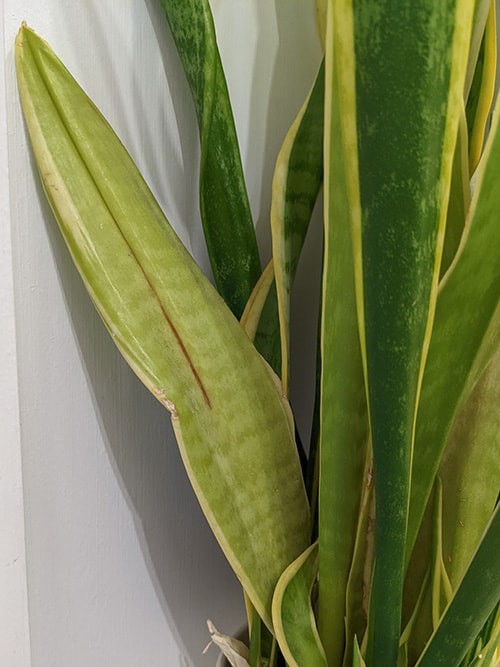Snake Plant Leaves Turning Yellow Can Be Fun For Everyone
Wiki Article
The 2-Minute Rule for Snake Plant Leaves Turning Yellow
Table of ContentsSnake Plant Leaves Turning Yellow Things To Know Before You Get ThisSnake Plant Leaves Turning Yellow Things To Know Before You Get ThisThings about Snake Plant Leaves Turning YellowThings about Snake Plant Leaves Turning YellowGetting The Snake Plant Leaves Turning Yellow To Work
Below are seven factors your serpent plant's leaves might be transforming yellow and just how to repair it. A number of various plant issues can trigger yellow fallen leaves, or chlorosis. Chlorosis takes place when plants do not have the micronutrients they require to generate chlorophyll, that makes foliage eco-friendly and enables plants to convert sunshine into food.Snake plants are dry spell forgiving many thanks to their delicious leaves. These plants grow best in loose, well-drained soil that's enabled to dry out totally in between waterings and might just need water once per month during winter season. Overwatering can protect against roots from taking in moisture and nutrients that the plant requires and can even trigger root rot.
A potbound plant can not absorb nutrients from the dirt. If your serpent plant is overcrowded or outgrowing its pot, this might be the cause of yellow fallen leaves.
See to it the plant has intense, indirect light and regularly cozy temperature levels, and water only when the dirt has fully dried. Watch out for issues and capture them beforehand to maintain your plant looking healthy and balanced and attractive.
Some Known Questions About Snake Plant Leaves Turning Yellow.
If the leaves on your snake plant are obtaining soft, it's normally an indication of way too much water. Snake plants store water in their fallen leaves and if they're overwatered, the fallen leaves can become soft and mushy. If you think your serpent plant is being overwatered, allow the dirt to dry out totally prior to watering once more.Yes, some yellowing is normal and to be anticipated on older leaves, especially as serpent plants age. If the plant is or else healthy and the leaves are only lightly yellowed then there is no reason for problem. However, if the leaves are substantially yellowed or if there are various other indicators of distress then it's finest to take action.
Dead fallen leaves can supply a home for insects and conditions, which can then spread out to the remainder of the plant. To eliminate a dead fallen leave, just suffice off at the base with a sharp knife or scissors. Make certain to disinfect your reducing device between cuts to stop the spread of condition.
This can vary depending upon the dimension of the pot, the type of potting mix, and the temperature level and humidity degrees. In general, serpent plants need to be sprinkled every one to 2 weeks. Throughout the cold weather, you can lower watering to once a month. Snake Plant Leaves Turning Yellow. If you learn this here now believe your serpent plant has actually been overwatered, the primary step is to stop sprinkling it.
The 10-Minute Rule for Snake Plant Leaves Turning Yellow
With a little investigation, you must have the ability to identify the reason and take actions to take care of the trouble and have a healthy serpent plant.The serpent plant is a great houseplant. The snake plant is one of those plants that are excellent for expanding indoors in a terrarium, Snake plants can grow quite huge, but they likewise often tend to be pretty low-maintenance.
When the dirt is overwatered, the plant cells soak up more water than they can store. Read below to Leaves come to be soggy and yellow as they soak up a lot more water. Drooping serpent plant leaves are caused by soaked-up fallen leave cells losing their firmness. You may see that your snake plant will come to be black or brown if the yellow patches are not dealt with by dealing with overwatering.
It is, as a result, most likely that your plant will certainly spot yellow patches on its fallen leaves if you overfeed it with plant food throughout winter season. The leaves of snake plants are also susceptible to yellowing when overfed, especially if the roots are breakable. Repotting your yellowing, watering only when the dirt dries, and offering ideal temperature level and light conditions can save it.
Some Ideas on Snake Plant Leaves Turning Yellow You Need To Know

Your can be look at this site eliminated by reducing off the yellow tips. The pruned fallen leaves ought to expand longer if they are watered appropriately and have optimal light and temperature level problems. It is essential to keep in mind that the pointed tips will not regrow, creating them to stick out from right here the remainder of the leaves.
At the same time, you can remove damaged leaves from the base of the plant. The vital message is to allow the serpent plant time to recover.

Not known Incorrect Statements About Snake Plant Leaves Turning Yellow
A few of the most typical reasons are listed here (Snake Plant Leaves Turning Yellow). Sansevierias like completely dry environments and prefer little water maintained at a void of one or two times once a week in summer and monthly in wintertime. When the water dosage gets out of control, your Sansevieria will suffer from overwatering. One of the most usual problem provided by overwatering is origin rot resulting in mushy roots and stems with a nasty smell.Report this wiki page